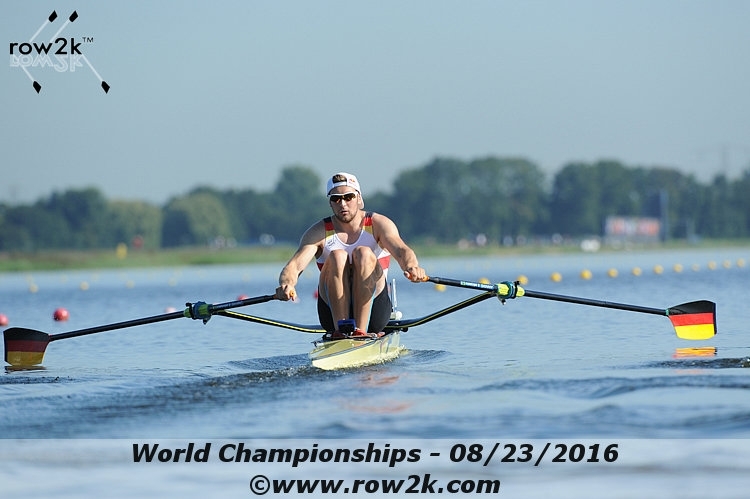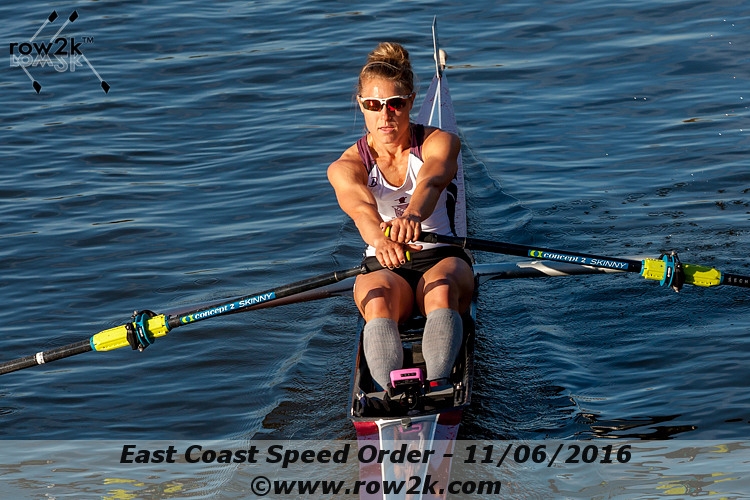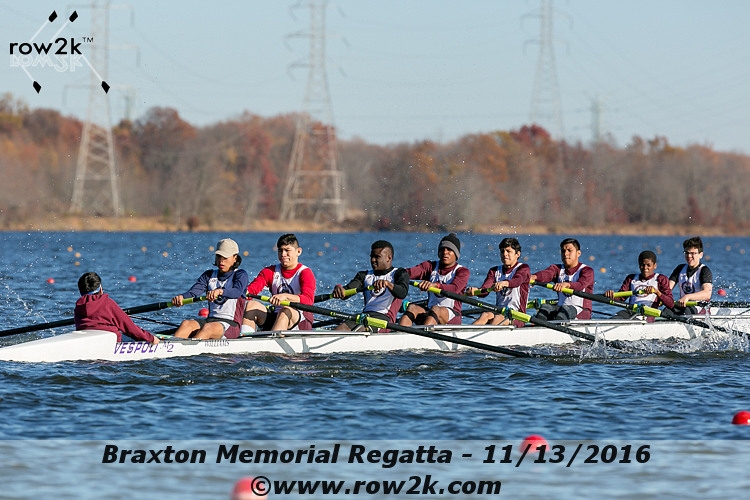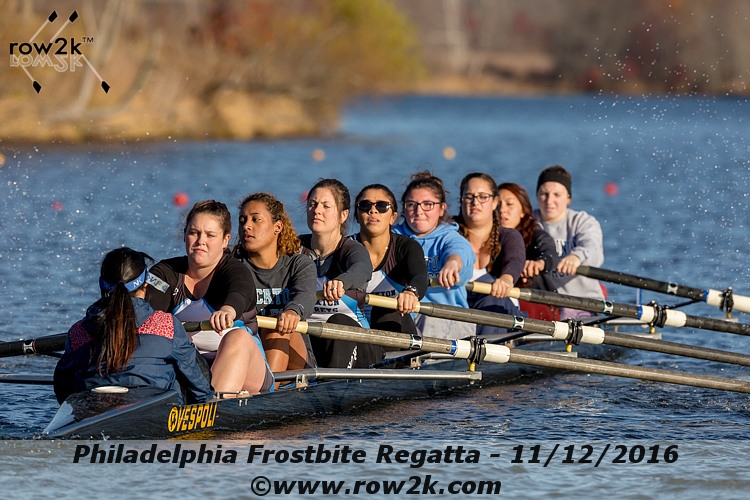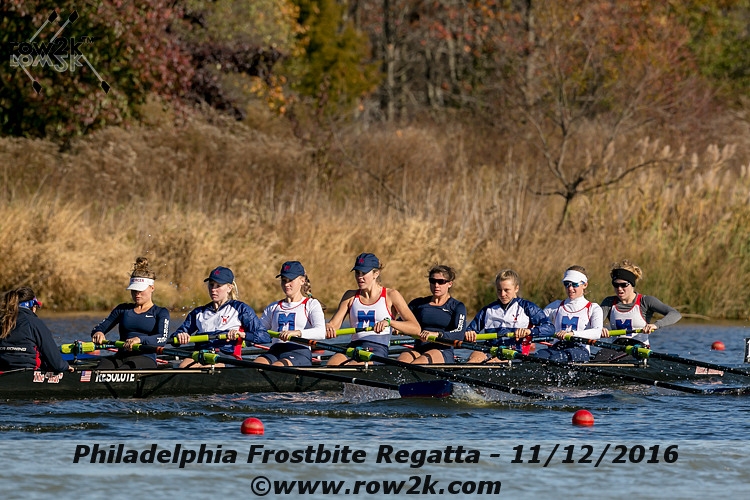
For experienced rowers, the Frostbite and Braxton regattas offer a unique autumn opportunity to do short pieces in practice, jack up the ratings, and start in on the mental game of 2k racing. And then come back and do it again – or maybe three or four times.
PNRA/Mercer women's team captain Laila Shehab raced four times over the weekend, twice in Saturday's Frostbite and twice in Sunday's Bill Braxton regatta. All told, she put in head racing miles (and then some), but was still focused on bringing the 2k heat in both the eight and the four.
"Going into fall racing, you're setting yourself up for a longer piece, so you're not going as all out per se," she said second win of the day on Saturday. "It's a completely different game, whereas junior 2k racing is so mental that if you get up on a crew in the top 500 meters, it can destroy them, and only a really good crew can walk back from being shut down so early. This week we decided to work on getting up off the start, because I think that's where we kind of had trouble last year.
"It can be easier to get up on a crew and then try to walk further away to get behind and try to find them again; mentally, it's harder. "
As we all know, there is a price to pay for getting the lead, as Shehab noted.
"The feeling is a lot more intense in your legs for sure," she said. "We raced a four this morning and won, but the first 500 meters felt forever. It took a long time to get there, and when you're racing and practicing in eights so much, going into a four, and then doing a really long piece in a four is hard; the feeling is a lot more intense in your legs for sure."
The shorter distance also requires a shift in training – and sometimes you have to do whatever it takes to get ready.
"We were not practicing starts until we finished the head races, and we just recently started doing shorter distances a higher stroke rate," Shehab said. "There was a workout that prepared us well for this; we did two by seven minutes, with 45 seconds on race pace at a 33-34, and then 15 seconds to shift down, to practice the shift right after the high 20. We would alternate that - 45 seconds on, 15 seconds shift down, and then bring it up again."
The crew went off today at a 41, though; how do you get from 33-34 to 41? Shehab paused, then knew the answer.
"Rush!" she said with a laugh.
Hey, we've all been there.
"Really, it's more like not worrying about being all the way at full slide, just getting the boat quickly just up to speed," she continued. "If you get it up high enough within that 10-15 strokes of the start, I think the shift can be a really dramatic push to the bow, which can just take you down the course."

Despite doing four races – and the resulting four starts and four sprints – Shehab took the workload in stride.
"When I was a freshman, I raced five times a day in five events at Canadian Henley and got all my boats in the final or won," she recalled. "I did the U19 pair, U19 eight, U19 four, U17 four, and U17 eightI always remember the pain that I felt during that day and go back to it when I need it. And I don't want to let my crew down, and the amount of pain that I'm in, they're feeling the same thing. It's a lot of teamwork and trusting the other person to go just as hard as you are.
"I just try just to go as hard as I can for that stroke," she said of her approach. "Because you can do anything for eight minutes. Mentally it can be hard, because you are warming up for your last race of a really long day and you're thinking 'I have another 2000 meters to go of hard work.' At the Canadian Henley, I was stroking the U17 eight, and tried just to set up a good rhythm for other people to follow. It's not paying attention to how tired you are or the burn in your muscles as you get to the 500 meters to go mark. It's just you're going for your crew and you're going to win and you're going for your coach. So, there's a lot of trust in that, and we ended up winning a gold at that race."
Comments | Log in to comment |
There are no Comments yet
| |
If you enjoy and rely on row2k, we need your help to be able to keep doing all this. Though row2k sometimes looks like a big, outside-funded operation, it mainly runs on enthusiasm and grit. Help us keep it coming, thank you! Learn more.
- Bont Rowing
- Calm Waters Rowing
- Concept 2
- Craftsbury Sculling
- The Crew Classic
- CrewLAB
- Croker
- Dad Vail Regatta
- Durham Boat Co.
- Empacher
- Faster Masters
- Filippi
- Fluidesign
- h2row.net
- HUDSON
- Live2Row Studios
- Nielsen-Kellerman
- Oak Ridge RA
- Peinert Boat Works
- Pocock Racing Shells
- Race1 USA
- Rockland Rowing Masters Regatta
- RowKraft
- Rubini Jewelers
- Vespoli USA
- WinTech Racing
- Bont Rowing
- Calm Waters Rowing
- Concept 2
- Craftsbury Sculling
- The Crew Classic
- CrewLAB
- Croker
- Dad Vail Regatta
- Durham Boat Co.
- Empacher
- Faster Masters
- Filippi
- Fluidesign
- h2row.net
- HUDSON
- Live2Row Studios
- Nielsen-Kellerman
- Oak Ridge RA
- Peinert Boat Works
- Pocock Racing Shells
- Race1 USA
- Rockland Rowing Masters Regatta
- RowKraft
- Rubini Jewelers
- Vespoli USA
- WinTech Racing



